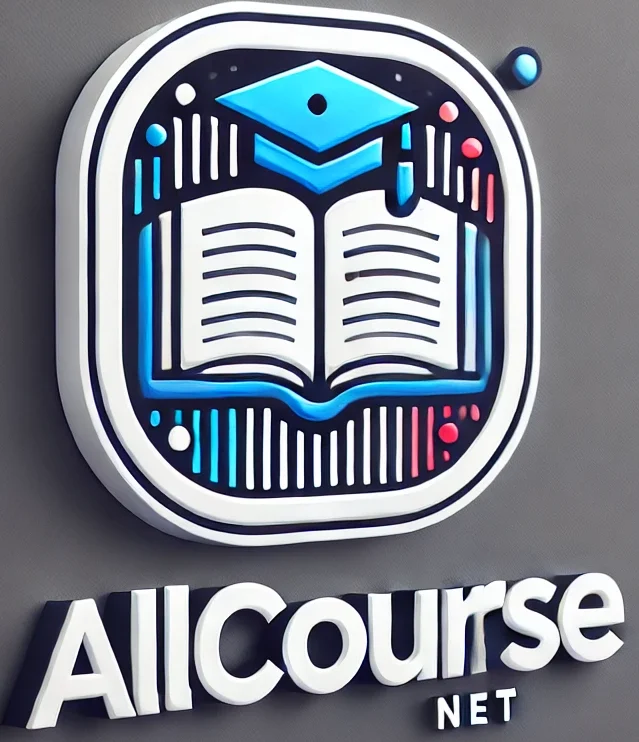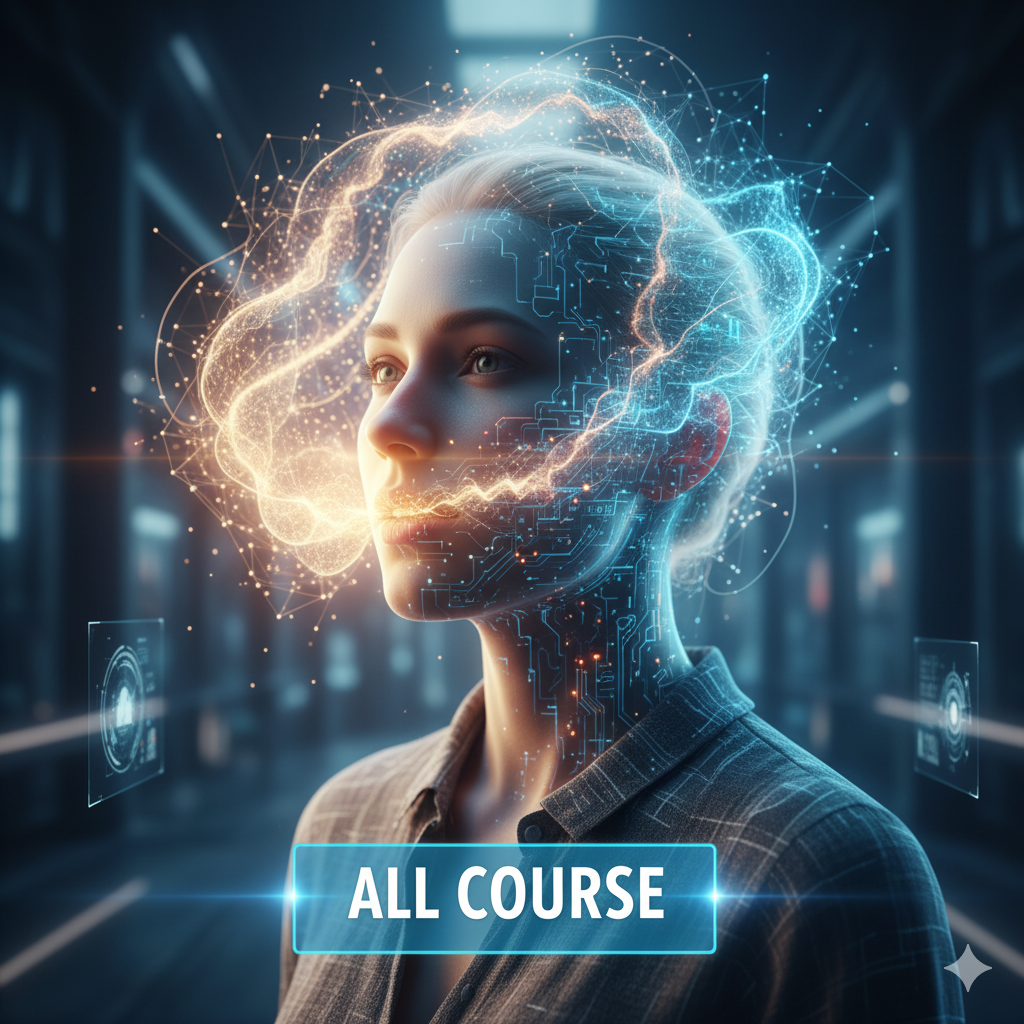When Communication Meets Artificial Intelligence
Introduction —A New Language of Learning Begins
Imagine practicing a big presentation while your computer quietly listens and gives feedback in real time.
It tells you when your tone sounds too flat, when your pace is too fast, and when a well-timed pause could make your words land with more power.
It’s not your manager or a speech coach — it’s an AI communication assistant, designed to help you speak with more confidence, clarity, and impact.
Not long ago, that kind of instant, personalized coaching was only possible with an expensive mentor or hours of one-on-one sessions. But in 2025, technology has changed the rules.
Artificial Intelligence has stepped into the world of communication skills training, turning what used to be a slow, subjective process into a dynamic, data-driven experience.
Why Communication Matters More Than Ever
No matter your profession, strong communication is the skill that opens every door. It influences hiring decisions, leadership potential, team collaboration, and even personal relationships.
Yet for decades, the way we learned to communicate hasn’t changed much — a few workshops, a presentation class, maybe a coaching session or two.
The problem? Traditional methods often lack personalization and consistency.
Feedback can be delayed, vague, or shaped by the trainer’s own perception. People might know the theory — “make eye contact,” “speak clearly,” “listen actively” — but they rarely get real-time, measurable insights to actually improve.
That’s where AI makes a difference.
The Rise of the AI Communication Coach
Artificial Intelligence is now acting as a 24/7 personal coach, analyzing speech patterns, tone, facial expressions, and even word choice.
Tools like Poised, VirtualSpeech, and Yoodli can now evaluate your presentation delivery, track your progress over time, and offer instant feedback that once took human coaches hours to prepare.
Whether you’re preparing for a job interview, leading a sales pitch, or just trying to sound more confident in meetings, AI offers objective, actionable feedback that helps you improve faster.
It’s like having a mirror that doesn’t just reflect — it teaches.
It’s About More Than Just Technology
What makes this transformation so powerful isn’t the technology itself — it’s the new understanding of how humans learn to communicate.
AI doesn’t replace empathy or authenticity; instead, it highlights the small details that make communication more human — tone warmth, pacing, emotional resonance.
In a time when so many conversations happen through screens, these insights help people connect better, not just speak better.
That’s why experts say AI isn’t replacing communication trainers — it’s reinventing them.
In this article, we’ll explore how AI is reshaping communication skills training in 2025:
-
How organizations and learners are using it
-
Which tools are leading the change
-
What challenges and ethical questions it raises
-
And how you can bring AI-powered learning into your own development journey
Let’s start with the foundation:
Why did traditional communication training need a shake-up in the first place?
Why Traditional Communication Skills Training Needs Disruption
For years, communication skills training looked pretty much the same everywhere.
You’d show up to a workshop, maybe with a coffee in hand, and sit through a few hours of theory — slides about body language, active listening, or persuasive speaking. There’d be some group exercises, a bit of role-play, polite applause, and a quick certificate at the end.
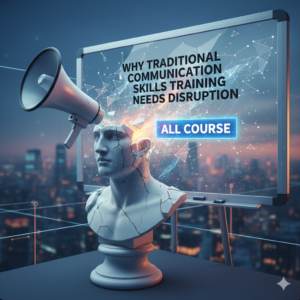
Then Monday rolled around, and… everything went back to normal.
The nerves returned before presentations. The “ums” and “uhs” slipped back into conversations. And the confidence you felt in that workshop slowly faded away.
Sound familiar? You’re not alone.
The truth is — traditional communication training isn’t broken, but it’s outdated.
It was built for a different world — one where learning was slower, feedback was delayed, and communication mostly happened face-to-face.
But the way we connect, collaborate, and express ourselves today has completely changed.
The Old Way Just Doesn’t Fit Anymore
Traditional communication workshops did their job for their time. They helped people find their voice and understand the basics of public speaking, storytelling, and interpersonal skills.
But in today’s fast-moving, digital-first world, those same methods are struggling to keep up.
Here’s why:
Feedback Comes Too Late
In most workshops, you might give one short presentation, get notes from your trainer, and that’s it.
But by the time you hear what went wrong, the nerves are gone and the lesson doesn’t really sink in.
It’s like getting driving feedback after you’ve already parked the car — it just doesn’t help you improve in real time.
One Size Fits No One
Everyone communicates differently.
Some people speak fast and passionate, others calm and measured. Some struggle with confidence; others talk too much.
Yet, most traditional courses treat everyone the same — same techniques, same exercises.
That’s not training; that’s mass production. And it doesn’t work for something as personal as communication.
Human Feedback Isn’t Always Objective
Even the best trainers see things through their own lens.
What one coach calls “assertive,” another might call “too strong.”
That’s not because they’re wrong — it’s just human bias. But it makes it hard to track real progress or know what “better” actually looks like.
Practice Stops When the Workshop Ends
You can’t become a confident communicator in one day. Like fitness, communication improves with consistent practice — not occasional effort.
But traditional programs rarely offer ongoing feedback or daily reinforcement. Once you leave the session, you’re on your own again.
It’s Expensive and Hard to Scale
One-on-one coaching can be life-changing, but it’s also costly.
That means many organizations can only afford to train a few people — usually executives — while everyone else gets left behind.
The Way We Communicate Has Completely Changed
Look around — communication today happens everywhere and all at once.
We speak on Zoom calls, lead hybrid meetings, send voice notes, and pitch ideas to people we’ve never met in person.
Your “stage” might be your laptop camera, and your audience could be halfway across the world.
Yet, most communication training still assumes we’re all standing in front of a physical audience with a clicker in hand.
That gap — between how we used to communicate and how we actually communicate now — is exactly where traditional training starts to fail.
Today, you need to know:
-
How to sound confident on camera, not just in person.
-
How to express empathy through text or virtual tone.
-
How to connect with global teams across time zones and cultures.
That’s a whole new skill set — one that old-school methods weren’t built to teach.
The Moment for Change Is Now
By 2025, communication has become one of the most valuable professional skills — not a “nice-to-have,” but a career essential.
Teams that communicate well move faster. Leaders who communicate clearly inspire trust. Brands that communicate authentically win hearts (and markets).
But while the demand for these skills is exploding, the traditional way of teaching them can’t keep up.
People want learning that’s:
- Instant
- Personalized
- Measurable
- Continuous
And that’s exactly where AI steps in.
Artificial intelligence isn’t here to replace human coaches — it’s here to amplify what they do best.
AI can analyze tone, pacing, confidence, and even emotional cues in real time. It can give instant feedback, track improvement over time, and personalize lessons to fit how you communicate — not how the “average learner” does.
It’s like having a coach who’s available 24/7, patiently helping you refine your voice one conversation at a time.
The Start of a Communication Revolution
The future of communication training isn’t about choosing between people and technology — it’s about combining the two.
AI brings precision, speed, and accessibility. Human coaches bring empathy, understanding, and context.
Together, they’re transforming how people learn to speak, listen, and connect.
A quiet revolution is happening — one where communication training is continuous, data-driven, and truly human.
Because at the end of the day, AI isn’t replacing human communication…
It’s helping us become better at it. 💬
How AI Is Being Applied Today — Real Tools, Real Training, Real Results For Communication Skills
So, now that we understand why traditional communication training needs a reboot, let’s talk about the exciting part — how AI is actually changing the game.
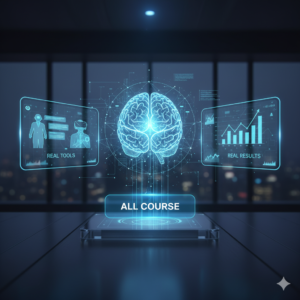
We’re no longer talking about some far-off, futuristic technology.
In 2025, AI-powered communication training is happening right now — in classrooms, corporate boardrooms, and even on our smartphones.
From personalized speech coaches to real-time feedback apps, AI is quietly transforming how people learn to speak, listen, and connect.
Let’s look at what that transformation looks like in real life. 👇
AI-Powered Personal Speech Coaches
Imagine practicing a presentation and getting instant, honest feedback — not days later, but as you speak.
That’s exactly what AI-powered tools like Orai, Yoodli, and Poised are designed to do.
These apps “listen” to your voice and analyze everything from your tone, pace, and clarity to your use of filler words and even your emotional energy.
They don’t just tell you what’s wrong — they show you how to fix it.
For instance:
- “Try slowing down; your pace picked up after the second paragraph.”
- “Your tone sounds flat. Add some vocal variety for emphasis.”
- “You said ‘um’ seven times — let’s work on that.”
It’s like having a coach who’s patient, data-driven, and available 24/7.
And because the feedback is objective and immediate, learners improve faster — and with more confidence.
Virtual Reality and AI for Real-Life Scenarios
One of the biggest challenges in communication training is that practice doesn’t always feel real.
You might be rehearsing a speech in front of your mirror or a small class, but it’s hard to replicate the pressure of a real audience.
That’s where AI + VR (Virtual Reality) is stepping in.
Platforms like VirtualSpeech or BodySwaps use AI-driven virtual environments to simulate real-world speaking situations — from presenting at a conference to leading a team meeting or handling a tough client negotiation.
The virtual audience reacts in real time — smiling, frowning, getting distracted — and AI tracks your body language, voice projection, and eye contact.
When it’s over, you get a full performance report with suggestions for improvement.
The result? A safe space to fail, learn, and improve — before facing the real thing.
AI in Writing and Everyday Digital Communication
In 2025, “communication skills” aren’t just about speaking — they’re also about how we write.
Emails, chat messages, and social posts now carry as much weight as face-to-face conversations.
That’s why tools like GrammarlyGO, Wordtune, and Jasper AI have become everyday writing assistants.
They do much more than correct grammar — they help users:
- Adjust tone (formal, friendly, persuasive)
- Reframe messages for clarity or empathy
- Simplify complex ideas without losing meaning
- Maintain confidence and authenticity in their writing
In short, AI is teaching people not just to write correctly, but to communicate effectively.
Real-Time Feedback During Meetings
In professional settings, communication doesn’t just happen during presentations — it happens in meetings, brainstorming sessions, and spontaneous conversations.
Now, AI tools like Zoom’s AI Companion, Otter.ai, and Fireflies can analyze speech patterns during meetings, identify dominant speakers, and even flag communication imbalances — like when one person is interrupting others or when key voices aren’t being heard.
For team leaders, this is a breakthrough.
It creates a feedback loop that helps organizations build healthier, more balanced communication cultures — something traditional training never had data for.
AI-Powered Learning Platforms for Soft Skills
AI isn’t just changing how we train — it’s changing who can access that training.
Platforms like Coursera, LinkedIn Learning, and Udemy now use AI algorithms to recommend personalized learning paths for communication and presentation skills.
Instead of sitting through generic lessons, learners get:
- Tailored video modules based on their strengths and weaknesses
- Interactive quizzes that adjust difficulty in real time
- AI summaries and key takeaways for faster retention
In essence, AI makes learning personal and continuous, rather than one-time and forgettable.
Real Results, Real Impact
Companies that have adopted AI-based communication training are already seeing results:
- Sales teams are closing more deals thanks to clearer, more empathetic client conversations.
- Leaders are delivering more engaging virtual presentations that keep teams aligned.
- Employees report feeling more confident speaking up — both online and in person.
And it’s not just corporate — educators, entrepreneurs, and students are all using these tools to refine their communication style, prepare for interviews, and build personal brands.
The Human-AI Partnership
It’s important to remember: AI isn’t replacing human communication coaches.
It’s enhancing them.
The best results come when AI handles data — things like tracking speech patterns, timing, or tone — while human mentors handle the why: empathy, creativity, emotion, and authenticity.
This partnership is creating a new learning model where technology provides insight, and humans provide understanding.
A Glimpse into the Future
The future of communication training is already taking shape — a space where anyone, anywhere, can get real-time coaching that feels both smart and human.
AI is making communication more measurable, but also more personal.
Because at its heart, communication is still — and will always be — about connection.
AI just gives us better tools to master it. 💬✨
The Tools Leading the AI Communication Revolution
By now, it’s clear that AI isn’t just a buzzword — it’s a genuine revolution in how we learn, work, and connect.
In communication skills training especially, AI tools have become powerful partners: they listen, analyze, guide, and adapt — almost like having a coach in your pocket.

What’s even more exciting is how accessible these tools have become. Whether you’re a public speaker, a manager leading virtual teams, a student prepping for interviews, or a professional trying to polish your online presence, there’s an AI tool designed to help you communicate smarter and with more confidence.
Let’s explore the leading platforms shaping this new era — and what makes each of them special. 🚀
Yoodli – The AI Coach That Listens Like a Human
Best for: Public speakers, professionals, and students who want real-time, personalized speaking feedback.
Yoodli has become one of the breakout tools in 2025.
It uses AI to analyze your speech delivery, eye contact, pacing, and filler word usage during presentations or practice sessions.
After you finish speaking, Yoodli gives you instant, personalized insights — highlighting where your confidence shines and where you could improve.
Key features:
-
Real-time speech feedback and confidence tracking
-
Speech analysis based on clarity, tone, and body language
-
Interactive dashboards showing improvement over time
-
Gamified learning (you earn “communication streaks” and challenges!)
It’s not about robotic perfection — it’s about learning to sound like your best self.
Poised – Your Always-On Communication Assistant
Best for: Remote professionals, leaders, and hybrid teams.
Poised integrates directly into video platforms like Zoom, Google Meet, and Microsoft Teams — giving you live feedback while you’re actually speaking in meetings.
Imagine your AI assistant whispering in your ear (discreetly!) during a meeting, saying things like:
“Try to slow down — you’re rushing through key points.”
“Your tone dropped — add energy for engagement.”
After the meeting, Poised generates a detailed report, complete with AI-driven suggestions for improving your tone, engagement, and delivery next time.
Key features:
- Real-time feedback during live meetings
- Post-meeting analytics and improvement insights
- Emotional tone and clarity scoring
- Integration with major video platforms
It’s like having a personal communication coach — one who’s invisible, non-judgmental, and always available.
Orai – Speak Confidently Anytime, Anywhere
Best for: Aspiring public speakers and individuals wanting to improve confidence.
Orai is designed for people who want to improve their public speaking and storytelling skills on the go. You can record short clips, practice key phrases, or rehearse full presentations — and Orai will break down your performance instantly.
Key features:
-
Instant AI feedback on pace, clarity, energy, and filler words
-
Personalized lessons based on your performance
-
Progress tracking and speech scoring
-
Audio-only practice (perfect for busy professionals)
The app’s goal is simple: help you sound natural, clear, and confident — whether you’re presenting at work or giving a toast at a wedding.
VirtualSpeech – Learn by Doing (in Virtual Reality)
Best for: Learners who want realistic, immersive speaking practice.
VirtualSpeech takes communication training to another level — literally, into a virtual world.
It combines VR technology and AI feedback to create real-world speaking scenarios: business presentations, conference speeches, networking events, or even interviews.
When you put on your VR headset, you’re not in a classroom — you’re on stage, facing a lifelike audience that reacts to your tone, eye contact, and body language.
After your “speech,” you get data-driven insights and confidence scores.
Key features:
-
Immersive VR speaking environments
-
AI-generated feedback on body language, tone, and confidence
-
Custom training modules for leadership, sales, and presentations
-
Realistic audience simulations
VirtualSpeech is proof that practice doesn’t have to feel artificial. It’s where stage fright meets smart tech — and finally, you win.
GrammarlyGO – Writing With Empathy and Clarity
Best for: Professionals who rely heavily on written communication.
If speaking is half of communication, writing is the other half — and GrammarlyGO is like your writing wingman.
Beyond grammar correction, this AI tool helps you refine tone, adapt to your audience, and strengthen clarity in every message — whether it’s an email, proposal, or social media post.
Key features:
-
Tone detection (formal, persuasive, confident, friendly)
-
AI rephrasing for clarity and impact
-
Real-time writing enhancement
-
Custom voice personalization for brand or personal tone
For anyone who wants to sound polished but still authentic, GrammarlyGO is a daily essential.
BodySwaps – Learn by Reflecting on Yourself
Best for: Educators, HR teams, and leadership development.
BodySwaps uses VR and AI to let users “step into someone else’s shoes” — literally.
You can practice difficult conversations, leadership scenarios, or interviews by “swapping bodies” with a virtual character to see how you come across.
It’s an incredibly powerful empathy-building tool.
AI tracks your tone, wording, and reactions, giving feedback on how your message might be perceived.
Key features:
-
Immersive role-play training in VR
-
Real-time feedback on empathy, tone, and assertiveness
-
Scenario-based learning (e.g., conflict resolution, feedback delivery)
-
Ideal for leadership and emotional intelligence training
BodySwaps reminds us that the best communicators don’t just speak — they connect.
Coursera & LinkedIn Learning – Personalized AI Learning Paths
Best for: Continuous learners and organizations investing in skill development.
Platforms like Coursera and LinkedIn Learning are now powered by AI to create personalized communication skill roadmaps.
The AI tracks your completed courses, strengths, and weak areas, then recommends the next best lessons — whether that’s mastering persuasive storytelling or improving digital body language.
Key features:
- Adaptive learning based on performance
- Expert-led courses with AI-tailored pacing
- Certificates to boost career credibility
- Integration with corporate learning systems
In other words, your learning journey becomes as unique as your communication style.
Rehearsal AI – The Practice Platform for Professionals
Best for: Sales teams, executives, and customer-facing professionals.
Rehearsal AI allows users to record their communication practice sessions, submit them for AI + human review, and get personalized video feedback.
It’s heavily used by companies for sales training, leadership communication, and media preparation.
Key features:
- Video-based practice with instant AI scoring
- Optional coach feedback
- Analytics for communication improvement
- Team learning dashboards for corporate training
It bridges the gap between self-paced learning and professional coaching — the best of both worlds.
Why These Tools Matter
All these platforms share one core philosophy:
communication isn’t about perfection — it’s about progress.
They help people learn faster, gain self-awareness, and build confidence — without judgment, without fear, and without waiting for the next workshop to roll around.
In 2025, that’s what makes AI communication training so powerful:
It’s accessible, personalized, and human at its core.
AI doesn’t just make us better speakers or writers — it helps us become better listeners, better collaborators, and ultimately, better humans.
The Challenges and Ethical Questions Behind AI in Communication Training
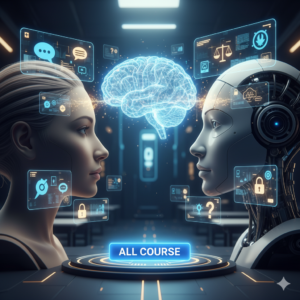
Artificial Intelligence has changed the game for communication training — it listens, learns, and helps us refine how we express ourselves like never before.
But behind the sparkle of innovation lies a quieter, more complex conversation: what do we lose — or risk — when we let algorithms shape something as deeply human as communication?
Because let’s be honest: our voices, our expressions, our pauses — they carry our personality, culture, and emotion. They’re not just data points.
And when AI starts analyzing them, people naturally start to ask — how much is too much?
The Privacy Paradox — “My Voice, My Data”
The foundation of AI communication tools is data — your data. Every word you say, every tone shift, every gesture you make can be captured, analyzed, and stored.
And that’s where the first big challenge arises: privacy.
When someone uploads their speech for AI analysis, they’re not just sharing words — they’re sharing their identity. Their voice is unique, as distinctive as a fingerprint.
So, questions like these become unavoidable:
-
Who owns the recordings once they’re uploaded?
-
Can companies use them to train their algorithms further?
-
Are they truly deleted when you hit “delete”?
The reality is, many users still don’t fully understand where their data goes after it’s analyzed.
Even with strict compliance laws like GDPR or CCPA, the fear of data misuse lingers.
Forward-thinking AI companies are addressing this through radical transparency — giving users full control, end-to-end encryption, and clear consent options. But until these practices become universal, privacy will remain one of AI’s biggest trust hurdles.
Because in the end, people want to improve their communication — not compromise their digital safety.
When Machines Miss the Moment
AI is brilliant at spotting patterns — but emotion? Not always.
It can tell when your voice dips too low or when you overuse filler words, but it can’t always interpret why.
Was your tone quiet because you were nervous? Thoughtful? Speaking about something painful?
Imagine an AI feedback tool flagging a speaker at a memorial service for sounding “too flat” — technically accurate, but emotionally tone-deaf.
Moments like these reveal a simple truth: AI doesn’t yet understand human context.
That’s why the future isn’t about replacing human communication coaches; it’s about augmenting them.
AI provides measurable insights — pitch, pacing, clarity — while human mentors provide meaning, compassion, and interpretation.
The magic happens when both work together.
The Fear of Sounding Like Everyone Else
One of the quiet ironies of AI coaching is that while it helps us find our voice, it can also make us sound… the same.
When everyone uses the same tone suggestions, the same “confidence markers,” and the same phrasing tips, you start hearing a kind of AI-approved sameness.
And communication — real, human communication — was never meant to be uniform.
Your voice isn’t supposed to sound like a TED Talk template.
It’s supposed to sound like you — with your natural rhythm, humor, accent, and emotion.
Yes, AI can polish our delivery, but it shouldn’t sand away our individuality.
The goal isn’t to be perfect — it’s to be authentic. To speak in a way that feels real, relatable, and deeply you.
So as helpful as AI can be, we have to remember that great communication isn’t robotic precision — it’s emotional connection.
Bias in the Algorithm — The Hidden Flaw
AI tools are only as unbiased as the data they’re trained on — and unfortunately, that data often carries hidden biases from the real world.
For instance:
- Accents from non-native English speakers might be rated as “less clear.”
- Cultural communication styles — like expressive hand gestures or emotional speech — might be seen as “unprofessional.”
- Even gender differences in tone or phrasing can affect AI feedback.
This doesn’t happen because AI is malicious — it happens because humans built it, and human bias sneaks into the data.
To fix this, developers are now diversifying their datasets, training AI to understand global accents, emotional variety, and cultural nuance.
It’s not perfect yet — but it’s improving fast.
And that’s crucial, because if AI is to help us communicate better, it must first learn to listen to everyone fairly.
When Data Overshadows Emotion
One of the most subtle yet serious challenges of AI communication training is what we might call the “data trap.”
It’s when learners start caring more about their AI scores than their audience’s reaction.
You know the feeling — chasing that perfect 95% “clarity” score, optimizing every pause, overthinking every sentence.
But in doing so, people risk losing the soul of their message.
Because communication isn’t a science experiment. It’s art. It’s empathy. It’s that spark you create when you connect with someone — not a number on a dashboard.
AI should be a mirror, not a master.
A tool that helps us become aware of our habits — not something that defines whether we’re “good enough.”
Ethics by Design — Building AI with Humanity in Mind
The good news? The industry is learning fast.
AI developers, educators, and ethicists are beginning to work hand-in-hand to design systems that value integrity, diversity, and emotional intelligence.
Some platforms are introducing:
-
“Human-in-the-loop” systems, where real coaches review AI feedback to ensure accuracy.
-
Bias audits, ensuring the AI’s training data includes varied voices and speaking styles.
-
Emotional intelligence modeling, helping AI understand context and empathy better.
-
User control features, so people can delete or anonymize their data whenever they wish.
In short: the future of AI communication isn’t just about smarter technology — it’s about kinder technology.
The Heart Still Matters Most
At the end of the day, communication is about one simple thing: connection.
AI can analyze your delivery, improve your phrasing, even help you manage stage anxiety — but it can’t replicate the warmth of a genuine smile, the power of empathy, or the courage it takes to share your story.
Technology can teach you how to speak, but only you can speak from the heart.
That’s the balance we need to protect: using AI to amplify our skills without losing the messy, beautiful imperfections that make us human.
Because the future of communication isn’t just about being more precise —
It’s about being more present, more human, and more aware of how we connect with one another.
The Future of Communication Training — Where AI and Humanity Work Hand in Hand
If the last few years have taught us anything, it’s this: technology isn’t replacing us — it’s reshaping us.
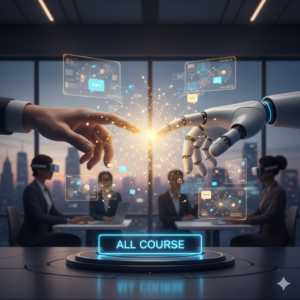
AI isn’t here to take over communication; it’s here to help us rediscover it.
In a world where messages travel faster than ever, where meetings happen across continents and cultures, and where attention spans shrink by the second — learning how to truly connect has never been more important.
So what does the next chapter look like?
Let’s step into the near future — where AI and humanity collaborate to build a new generation of confident, emotionally intelligent communicators.
From Classroom to Cloud: Communication Training Without Borders
Gone are the days when professional communication training meant flying to a conference room or attending a week-long seminar.
By 2025 and beyond, AI-powered virtual training platforms have become the norm — accessible anytime, anywhere.
Picture this:
You’re giving a presentation in a virtual training hub powered by AI.
As you speak, an intelligent assistant quietly tracks your tone, body language, and pacing. Afterward, it shows you a playback — not to criticize, but to coach you.
It highlights moments when your energy dipped, points where you connected strongly with your audience, and even suggests storytelling cues based on your speech rhythm.
Meanwhile, a human mentor joins the session later, reviewing the same analytics and helping you translate that feedback into emotional awareness:
👉 “You slowed down here — that’s where the audience really leaned in.”
👉 “This pause? Perfect. You gave them time to absorb your point.”
This blend of AI precision and human empathy is becoming the gold standard.
It’s not about replacing trainers; it’s about making training personal, accessible, and continuous.
Human Coaches + AI = The Ultimate Duo
Think of AI as your personal communication mirror — always available, always honest, but never judgmental.
It gives you data. It shows your habits. It tracks your growth.
But the interpretation — that comes from humans.
In the future, communication coaches will work alongside AI tools to create hyper-personalized learning paths.
Instead of guessing what a client needs, they’ll review detailed, unbiased AI insights to pinpoint exactly where improvement is needed — clarity, confidence, empathy, or listening.
AI will handle the analytics. Humans will handle the understanding.
This partnership will make coaching more powerful, affordable, and inclusive than ever before — so that everyone, not just executives, can access meaningful communication support.
Emotion-Aware AI: Teaching Empathy, Not Just Eloquence
One of the most exciting frontiers is emotionally intelligent AI — systems that don’t just listen to what you say, but understand how you feel when you say it.
These tools use advanced sentiment analysis and emotional modeling to detect subtle cues in tone, facial expressions, and rhythm.
They can sense nervousness, detect tension, and even spot genuine warmth or excitement in your delivery.
Imagine an AI that gently says:
“You sounded uncertain here — try taking a breath before your next key point.”
Or
“Your enthusiasm really came through when you told that story — lean into that energy.”
This isn’t sci-fi anymore. Companies like Rehearsal AI, Yoodli, and Poised are already integrating emotional analytics into their platforms.
And as these systems evolve, they’ll do more than improve delivery — they’ll help people rediscover authentic confidence.
Personalized, Continuous Learning: Growth That Never Stops
Traditional training ends when the session does.
AI-driven learning doesn’t.
In the future, your communication journey will be ongoing — guided by a virtual assistant that adapts to your growth in real time.
-
It’ll nudge you before an important meeting: “Remember to slow down during your introduction.”
-
It’ll celebrate your wins: “You reduced filler words by 30% this week — great progress!”
-
It’ll suggest new challenges: “Ready to practice assertive communication in negotiations?”
This always-on, personalized feedback loop turns communication training from a one-time event into a lifelong skill-building experience.
Learning will no longer be about memorizing tips — it’ll be about evolving through practice, feedback, and reflection.
Accessibility and Inclusion at the Core
Perhaps the most heartening part of AI’s rise is how it’s democratizing access.
In the past, high-quality communication coaching was expensive and reserved for senior leaders.
But now, AI-powered tools are available to students, freelancers, job seekers, and professionals at every level.
This shift is especially meaningful for people from underrepresented backgrounds or non-native speakers who have historically been judged more harshly on “communication standards.”
AI, when designed ethically and inclusively, can help level that playing field — offering fair, objective, and personalized guidance for everyone.
The result?
A world where confidence and clarity aren’t privileges — they’re universal skills.
A Future Fueled by Balance — Not Replacement
Here’s the truth most futurists now agree on:
AI will never replace the human voice — it will simply help us hear it more clearly.
The most powerful communicators of the next decade won’t be the ones who sound “algorithmically perfect.”
They’ll be the ones who use technology to become more self-aware, empathetic, and emotionally intelligent communicators.
In this new era, AI will handle what it does best — data, structure, analysis — while humans remain the soul of every message.
Because ultimately, the purpose of communication isn’t to sound flawless — it’s to be felt.
And that’s something no algorithm can replicate.
A New Definition of “Smart” Communication
If we look ahead, “smart communication” will no longer mean speaking with perfect diction or having the smoothest delivery.
It’ll mean speaking with presence.
Listening with intention.
And connecting with empathy — both online and off.
AI can help us polish our voices, but humanity will always be the heart behind the words.
That’s the balance the world is moving toward: AI-powered confidence, human-centered connection.
Final Thought: The Human Voice, Evolved
The future of communication training isn’t about humans vs. machines.
It’s about collaboration — a partnership where AI sharpens our skills, while our humanity gives those skills purpose.
So yes, the way we learn to communicate is changing. But the reason we communicate?
That remains beautifully timeless.
We speak to understand.
To inspire.
To belong.
And in that, no algorithm will ever outshine us. 💫
Conclusion: The Human Voice in the Age of AI
We’ve arrived at a remarkable crossroads — a moment where technology and humanity aren’t fighting for space, but learning to share it.

AI has quietly woven itself into how we write, speak, and connect. It gives us feedback faster than any mentor ever could, helps us understand our habits, and gives us the confidence to communicate more clearly.
But the deeper we go into this digital evolution, the more we realize something profound: the real power of communication still lives inside us.
Because at its core, communication isn’t about words — it’s about meaning.
It’s about the energy behind a message, the intention behind a smile, and the silence between sentences that says more than any paragraph ever could.
AI can measure, analyze, and optimize — but only humans can move hearts.
AI as a Mirror, Not a Mask
AI should never be the mask that hides your voice — it should be the mirror that helps you understand it.
When used wisely, it reflects who you are as a communicator:
your tone, your rhythm, your confidence, your habits — all laid bare, ready for reflection.
But that’s the beauty of it.
It doesn’t demand perfection; it invites self-awareness.
Instead of pretending to be someone else, you start learning how to express yourself — more naturally, more clearly, and more compassionately.
And that’s what true communication growth looks like: not sounding flawless, but sounding real.
Because your pauses, your laughter, your accent, your emotion — that’s your fingerprint. It’s what makes your communication yours.
AI can guide you toward clarity, but it’s your authenticity that builds connection.
Rediscovering What Communication Really Means
In a world obsessed with metrics — engagement scores, clarity percentages, sentiment charts — it’s easy to forget that communication isn’t about numbers.
It’s about understanding.
It’s about one human trying to reach another — across a screen, a meeting room, or even an entire continent.
The truth is, we don’t remember people for their perfect phrasing.
We remember how they made us feel.
That’s the secret to great communication: presence. The ability to show up, to listen deeply, and to speak from a place of empathy.
AI can teach us the techniques — how to modulate our voice, control our pacing, or reduce filler words.
But the moment you look someone in the eye, pause for effect, or share a story from your heart — that’s pure humanity.
That’s what makes people lean in.
So maybe the future of communication training isn’t just about how we speak — it’s about why.
A New Chapter: Collaboration, Not Competition
For years, people feared that AI would replace teachers, coaches, and communicators.
But as we’ve seen, the opposite is happening.
AI isn’t the competition — it’s the collaborator.
It’s helping trainers scale their wisdom, helping learners get instant feedback, and helping teams across the world stay connected.
This partnership between human intuition and machine intelligence is the foundation of the new communication era.
Imagine a world where:
-
A student in Pakistan, a marketer in Paris, and a leader in Tokyo all have access to the same level of personalized coaching.
-
AI feedback bridges language barriers, allowing voices from every background to be heard and understood.
-
Companies use AI not to monitor communication, but to empower confidence in their teams.
That’s not science fiction — that’s where we’re heading.
And it’s a future where communication becomes not just smarter, but kinder.
Keeping Humanity at the Center
As AI becomes more advanced, our responsibility grows, too.
We have to make sure that technology serves people — not the other way around.
The goal isn’t to create perfect speakers; it’s to help people express themselves with honesty, empathy, and courage.
So as organizations, educators, and individuals, we need to keep asking:
-
Are we building tools that make communication more human — or more mechanical?
-
Are we teaching people to connect — or just to perform?
The answers to those questions will define whether AI becomes a bridge or a barrier in the future of communication.
Because the human voice — in all its imperfection and warmth — deserves to remain the heart of every message.
The Real Future of Communication
When you strip away the algorithms and analytics, what remains is timeless:
the simple act of one person speaking — and another person truly listening.
That’s the heartbeat of human connection.
And maybe that’s the greatest gift AI can offer us — the ability to notice ourselves again.
To become more aware of how we sound, how we listen, and how our words make others feel.
If we use it right, AI won’t make us less human — it’ll help us become better humans.
More articulate, more empathetic, more intentional.
Because communication has never been just a skill — it’s a reflection of who we are.
And in that reflection, AI can help us see not perfection, but potential.
Final Reflection: Speak Human, Even in a Digital World
So, as the digital age deepens, let’s not fear the tools that help us grow.
Let’s shape them, guide them, and use them to bring out the best in us — not the most mechanical, but the most meaningful.
Let’s create a world where technology helps us speak with more heart, listen with more curiosity, and connect with more compassion.
Because at the end of the day, no matter how advanced the algorithm, the most powerful form of communication will always come from one place — the human heart.
